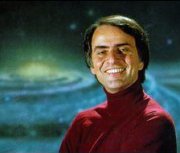 Sagan’s famous Tonight Show appearances happened right around the time I was old enough to stay up and see them. Early on I remember being annoyed by his criticisms of Star Wars (to wit: that spaceships don’t make whooshing noises in space, that Chewbacca deserved a medal at the end too, etc). But then my mom, who I think had a bit of a crush on him, urged me to read Broca’s Brain, and I was hooked on his brand of science education.
Sagan’s famous Tonight Show appearances happened right around the time I was old enough to stay up and see them. Early on I remember being annoyed by his criticisms of Star Wars (to wit: that spaceships don’t make whooshing noises in space, that Chewbacca deserved a medal at the end too, etc). But then my mom, who I think had a bit of a crush on him, urged me to read Broca’s Brain, and I was hooked on his brand of science education.
Then came Cosmos, which was eagerly anticipated in our household. We counted down to its premiere for weeks. When it finally aired, the cheesy new-age music and Sagan’s, er, limited acting abilities — the camera lingered forever on what was supposed to be his awestruck face as he sailed through the universe in his kinda lame “ship of the imagination” — left us at first unenthused. But then came his story of Eratosthenes and I got another one of those emotional learning moments that I wrote about yesterday. The following is from Cosmos, the companion book to the PBS series:
[Eratosthenes] was the director of the great library of Alexandria, where one day he read in a papyrus book that in the southern frontier outpost of Syene, near the first cataract of the Nile, at noon on June 21 vertical sticks cast no shadows. On the summer solstice, the longest day of the year, as the hours crept toward midday, the shadows of temple columns grew shorter. At noon, they were gone. A reflection of the Sun could be seen in the water at the bottom of a deep well. The Sun was directly overhead. […]
Eratosthenes asked himself how, at the same moment, a stick in Syene could cast no shadow and a stick in Alexandria, far to the north, could cast a pronounced shadow. […]
The only possible answer, he saw, was that the surface of the Earth is curved. Not only that: the greater the curvature, the greater the difference in shadow lengths. […] For the observed difference in the shadow lengths, the distance between Alexandria and Syene had to be about seven degrees along the circumference of the Earth [which] is something like one-fiftieth of three hundred and sixty degrees, the full circumference of the Earth. Eratosthenes knew that the distance between Alexandria and Syene was approximately 800 kilometers, because he hired a man to pace it out. Eight hundred kilometers times 50 is 40,000 kilometers: so that must be the circumference of the Earth.
This is the right answer. Eratosthenes’ only tools were sticks, eyes, feet, and brains, plus a taste for experiment. With them he deduced the circumference of the Earth with an error of only a few percent […] He was the first person accurately to measure the size of a planet.
In the TV show, when Sagan said matter-of-factly, “This is the right answer,” I got a lump in my throat. At once I was propelled farther down the paths of learning, teaching, science, and, of course, Carl Sagan fanhood.
It is more than just a shame that Sagan died before his time of a rare disease, ten years ago today. (This blog post is participating in a Carl Sagan “blog-a-thon” to commemorate the occasion.) There is no doubt that if he were alive today, he would never have permitted science to be debased by politics to the extent that it has in recent years. Sagan knew that we ignore science at our peril and excelled at conveying that message. He saved the world once before, by popularizing the nuclear winter theory of the aftermath of even small nuclear wars, assuring those insane enough to consider such wars that they could never avoid spelling their own doom as well as their enemy’s. Who will take up his mantle and bring the Promethean fire of science back to light a world darkened by his absence?
Cheesy new-age music? One of the themes is from the Movement 3 of Vangelis’ “Heaven and Hell” album. You should hear the whole thing; it’s fabulous. And the “Hell” part is pretty far from cheesy. Also parts of his superb “Albedo 0.39” album (Pulstar and Alpha I think) were used in Cosmos as well, as well as other albums.
http://www.vangelismovements.com/cosmos.htm
Before more Vangelis fans gang up on me, I should aver: Vangelis is a genius, his music is sublime, etc. “Cheesy new-age music” was just one of several things contributing to a disappointing first impression. For a highly conventional middle-class family in Queens in 1980 with somewhat limited cultural exposure, the music was a little too out-there and touchy-feely for our tastes; it sounded like something out of California, about which we third-generation New Yorkers were naturally suspicious. As I wrote, though, that disappointing first impression was very short-lived, of Cosmos as a whole but also of Vangelis’s music. Heck, a couple of years later I was the proud owner of the Blade Runner soundtrack. And in the quarter-century since, our horizons have all broadened by a factor of bill-yuns and bill-yuns.